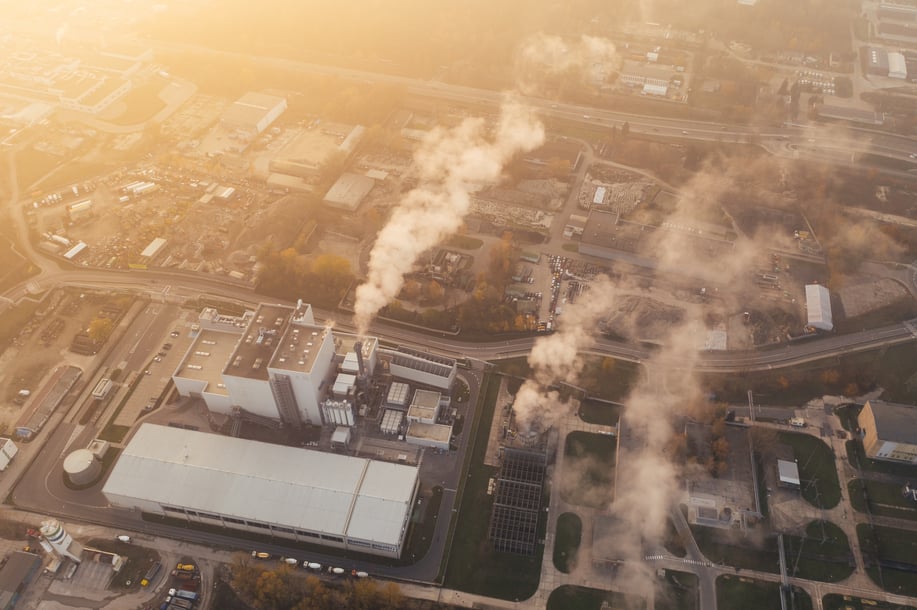
What is Embodied Carbon and Why is it Important?
| Last updated August 26, 2025
Historically, sustainable design has primarily focused on operational efficiency or operational carbon, meaning the energy usage once the space is occupied. However, with the growing emphasis on reducing carbon emissions, the scope of sustainable design has widened beyond operational carbon to include embodied carbon.
Very simply put embodied carbon is the carbon footprint associated with building materials. According to data from UNEP’s 2024 Global Status Report for Buildings and Construction Sector, the building sector is responsible for 34% of global energy-related carbon emissions, 18% of which come directly from the embodied emissions of construction materials.
The impact of embodied carbon on a building’s carbon footprint is clear. Knowing more about embodied carbon vs operational carbon – and how both affect our environment – can help architects and designers work toward more sustainable, carbon-neutral designs.
What is Embodied Carbon?
Specifically, embodied carbon refers to the greenhouse gas emissions (or GWP – global warming potential) arising from the extraction, manufacturing, transportation, installation, maintenance, and disposal of building materials.
Embodied carbon in buildings represents a significant percentage of global emissions. According to a report from Canadian Architect, the building industry is expected to more than double the number of buildings we currently have on the planet between now and 2060. Without a doubt, material choice can and will have a significant impact on construction embodied carbon.
When considering the impact of embodied carbon in buildings, think of the carbon emissions generated through material production, transportation, and installation. The amount of energy used in those processes (and the fuel used to provide that energy) is also factored into determining the embodied carbon.
Why is Embodied Carbon Important?
Embodied carbon is relevant and important because we need to reduce greenhouse gas emissions for the future of the planet. But, remember that currently, embodied carbon isn’t necessarily measured for net-zero builds! This is because of the tendency to focus on operational carbon (only looking at the building once it is occupied), and that is a huge miss.
Embodied carbon emissions will continue to increase with the increased global demand for construction materials. Giving our attention to the environmental impact of construction materials is absolutely warranted.
When selecting materials, remember that plant-derived materials store the carbon dioxide the plants absorbed during their growth. In other words, plants capture and store atmospheric carbon. Whether this stored carbon remains stored in those plant-derived materials depends on what happens to the materials at the end of the material’s life cycle.
Embodied Carbon vs Operational Carbon
Embodied Carbon Definition
Greenhouse gas emissions arising from a material’s
-
extraction
-
manufacture
-
transport
-
build
-
maintenance
-
demolition
-
end of life
Operational Carbon Definition
The emissions derived from the building once occupied (i.e. energy use).
What Documents Are Relevant to Embodied Carbon?
Material transparency through Environmental Product Declarations (EPDs) is vital to sustainable building design and to considering the embodied carbon of building materials. For example, with Fundermax phenolic panels, the EPD provides our GWP (that is embodied carbon). The sustainability manager can then make calculations reflecting how many square feet are being used, etc.
In addition to the EPD, you’ll want to consider a material’s
-
Corporate sustainability reports
-
Recycled content certifications

How Do You Measure Your Carbon Footprint?
Measuring your material or building carbon footprint means measuring embodied carbon. To effectively measure and calculate the embodied carbon of products, consistent methodology is imperative. For green buildings and construction materials, the EPD mentioned above is the agreed-upon tool for disclosure and transparency.
In order to quantify greenhouse gas emissions and their potential effects on climate change, scientists use a method called Life Cycle Assessment (LCA) to track the emissions produced over the full life cycle of a product or process. An LCA provides you with a chance to see the bigger picture of how a material impacts the environment.
Greenhouse gas emissions, including carbon dioxide, are added up over the product’s life cycle and reported as GWP (global warming potential). GWP is expressed in carbon dioxide equivalents (CO2e). This is an agreed-upon manner of expressing a product’s carbon footprint.
How Does This Help Architects?
Understanding embodied carbon vs operational carbon gives architects and designers even more opportunity to create more sustainable, carbon-neutral designs. Here is how it has helped in our industry and on our clients’ projects:
As phenolic panel manufacturers, we can measure and highlight how to reduce the environmental impacts of our products through publicly disclosed EPDs. Building designers can then use these LCA-based EPDs to determine the carbon footprint and overall environmental impact of a whole building.
From there, architects can look for ways to further reduce environmental impacts through strategies like
-
“Right-sizing” (using materials efficiently),
-
Selecting materials with more efficient manufacturing processes,
-
Using local materials to minimize transportation impact,
-
Using robust materials that require less maintenance, repair, and refurbishment,
-
Choosing materials that can be reused or recycled instead of landfilled.
For a more thorough look at construction embodied carbon, you may find our series of laboratory blogs helpful. Although focused on green lab initiatives in particular, the information is relevant to embodied carbon in buildings of call kinds. Consider these deep dives on Sustainable Lab Design, Material Transparency: EPD & HPD, and Durability vs Sustainability.
Fundermax has been committed to sustainability for more than a century. Throughout all of our operations, we are dedicated to continuously reduce environmental pollution and increase energy efficiency through measures we create and implement.
If you are an architect or building designer, our experts are available to discuss the unique qualities of phenolic panels, and our team can help support your sustainable design with superior materials. Contact us today for more information.

